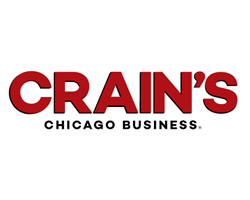Caterpillar's New CEO Has a Strategy That Can Be Summed Up In One Word

By Joe Cahill
September 22, 2017 - Scorched by an epic downturn, Caterpillar is treading cautiously under a new CEO who seems determined to avoid his predecessor's mistakes.
Jim Umpleby, who took charge of Deerfield-based Caterpillar in January, recently outlined a low-risk growth strategy for the heavy equipment manufacturer. From now on, Caterpillar will emphasize profit margins and investment returns over plant expansion, and try to augment equipment sales with services revenue.
"You won't hear any lofty sales goals today," Umpleby said at Caterpillar's investor day presentation on Sept. 12. He vowed to "drive profitable growth through margin expansion, asset efficiency and expanding our offerings, especially services," and promised to be "disciplined in our investing."
His mantra—cautious tops bold—is a familiar one among large manufacturers adjusting to a new era of modest economic growth and widespread uncertainty. Umpleby's strategy also marks a shift from the aggressive expansion campaign Caterpillar pursued under its previous leader. During the industry's last boom, Doug Oberhelman dramatically enlarged the company's footprint in a battle for global market share. Among other deals, Oberhelman paid $7.6 billion for mining equipment manufacturer Bucyrus International as commodity prices were peaking in 2011.
The spree gave Caterpillar enough production capacity for $100 billion in annual revenue, well above its record sales total of $65.9 billion in 2012. All that capacity left the company fully exposed to simultaneous slumps in construction and mining markets. Between 2012 and 2016, revenues plummeted 40 percent to $38.5 billion. Employees paid a heavy price as Oberhelman shuttered plants and reduced headcount by nearly 30,000.
"In the last upcycle, they overexpanded and got caught with too much capacity when the downcycle materialized," says analyst Matt Arnold at Edward Jones. "Going forward, there's going to be a more thoughtful and careful approach to expansion."

Jim Umpleby, left, and Doug Oberhelman
Expect little or no expansion in the short term, even as Caterpillar's markets begin to recover. Sales rose in 2017's first and second quarters, ending two straight years of quarterly declines. Despite a 25 percent reduction in manufacturing square footage, Umpleby told investors that Caterpillar still has plenty of capacity. "We believe our manufacturing capacity is sufficient for the foreseeable future. So capital expenditures will be less than depreciation and amortization for some time," he said.
Umpleby said the "operating and execution model" is proving itself in Caterpillar's construction equipment business. Profit margins in the unit climbed to 11 percent from 7 percent between 2013 and 2016 as revenue fell 20 percent. CFO Brad Halverson said rolling out the program companywide would increase overall profit margins to a range of 14 to 17 percent from 12 percent at $55 billion in sales.
Caterpillar is falling in line with other industrial giants aiming to boost profit margins and sell more services. Glenview-based diversified manufacturer Illinois Tool Works, for instance, has expanded its operating margin to 23 percent from 16 percent four years ago. Chicago-based Boeing aims to lift margins to the mid-teens range and triple services revenue.
Such initiatives reduce risk and buffer the cyclical downturns of volatile industrial markets. They also amount to a tacit admission that old-fashioned sales growth will be harder to come by in the years ahead. And they entail an ongoing focus on cost control likely to mean additional job cuts in targeted areas over time.
So far, investors see mostly upside. Caterpillar shares are up 35 percent this year, hitting an all-time high of $125.28 on Sept. 20.
Much of the rise reflects relief that the worst downturn in Cat's history is over. Plenty of questions remain about the future. Umpleby's profitability targets are enticing, but there's no telling when Cat's sales might return to the levels needed to produce those margins.

